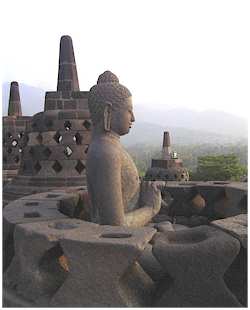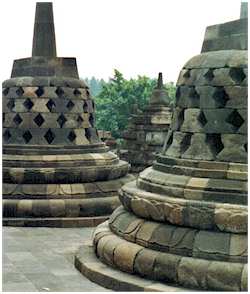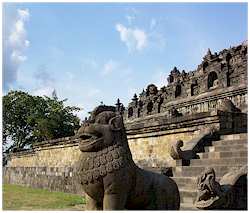HOME •
INDONESIA •
DISCOVER INDONESIA •
Borobudur
 BOROBUDUR, INDONESIA
BOROBUDUR, INDONESIA
Borobudur is a Buddhist stupa related to the Mahayana tradition, and is the largest Buddhist monument on earth. It is located in the Indonesian province of Central Java, 40 kilometers (25mi) north-west of Yogyakarta. It was built between 750 and 850 CE by the Javanese rulers of the Sailendra dynasty. The name may derive from the Sanskrit "Vihara Buddha Ur", which can be liberally translated as "the Buddhist temple on the mountain". It is one of the most popular tourist attractions in Indonesia.
 Borobudur is built as a single large stupa, and viewed from above takes the form of a giant mandala. The foundation is a square, 118 metres on each side. It has nine levels, of which the lower six are square and the upper three circular. This is said to be a map of the cosmos as conceptualized by the Buddhist philosophers of the time. The upper level features seventy-two small stupas surrounding one large central stupa. Each stupa is a bell shape pierced by numerous decorative apertures. Statues of the Buddha sit inside the pierced enclosures.
Borobudur is built as a single large stupa, and viewed from above takes the form of a giant mandala. The foundation is a square, 118 metres on each side. It has nine levels, of which the lower six are square and the upper three circular. This is said to be a map of the cosmos as conceptualized by the Buddhist philosophers of the time. The upper level features seventy-two small stupas surrounding one large central stupa. Each stupa is a bell shape pierced by numerous decorative apertures. Statues of the Buddha sit inside the pierced enclosures.
Borobudur is still a place of prayer and pilgrimage. Pilgrims circumambulate each level seven times in a clockwise direction. The stupas on the topmost level contain statues of the Buddha in various poses. According to local folklore, touching the finger and toe of a particular Buddha through the holes in the stupa wall brings good luck.
 CONSTRUCTION OF BOROBUDUR CONSTRUCTION OF BOROBUDUR
The volume of this massive andesite monument is approximately 56,000 m³. The stupa is formed of some 2,000,000 stone blocks. Archaeologists estimate that construction may have taken forty years. The logistics involved in assembling and feeding the huge work force necessary to complete the construction must have been daunting.
Some researchers say that during construction Borobudur experienced a landfall that threatened the entire building. To prevent the whole monument from collapsing, the Kamadhatu level was closed and made into a new base that holds Borobudur steady.
 SITE SELECTION SITE SELECTION
In the 1940s, the Dutch artist Nieuwenkamp suggested that Borobudur in fact represented the Buddha on a lotus leaf, and that thus had likely been built on a lake. In 1949, geologists found clay sediments near the site, which they interpreted as a remnant of a lake bed. They suggested that the lake may have been created by the eruption of a nearby volcano, Mount Merapi, either circa 1006 CE or much earlier. However, it was not at all clear whether the lake dried up before the stupa was built, or the site pre-dated a lake, which was an accident of nature.
More recent research indicates that a lake existed in the area as recently as between the 12th and 14th centuries, validating the earlier supposition that Borobudur was built as an aquatic lotus symbol, seen as floating on the adjoining lake
 INTERPRETATION INTERPRETATION
Scholars think that this massive monument is actually a gigantic textbook for illiterate Buddhists. As they performed their pilgrimage and circumambulated the monument, they passed walls ornamented with reliefs illustrating the life of Buddha Shakyamuni and the principles of his teaching.
The three levels of the monument are said to represent Kamadhatu (the world of desire), Ruphadhatu (the world of forms), and Arupadhatu (the world of formlessness).
• Kamadhatu
The Kamadhatu level was later enclosed, possibly to stabilize the structure. According to an early manuscript attributed to the sage Karmavibhangga, there were 160 relief panels on this first level. They depicted the world of passion and desire, and the inevitable results of passion, according to the laws of karma. The first 117 panels show various actions leading to one and the same result, while the other remaining 43 panels demonstrate the many results that follow one single effect. A few panels can still be seen on the southeast corner of the monument.
• Rupadhatu
Reliefs on the Rupadhatu level illustrate stories found in the Lalitavistara, Jataka-Avadana and Gandavyuha.
120 panels, based on the Lalitavistara, tell the story of Shakyamuni or Siddhartha Gautama, the Buddha of history.
Some panels tell stories from the Jataka tales, folklore about Shakyamuni's previous lives. Stories are told of his lives as a god, king, common man, or even an animal. He is said to have lived as a lion, deer, monkey, swan, turtle, etc. In every incarnation, Shakyamuni was noble and compassionate. These stories illustrate the Buddhist precepts in homely fashion.
Some panels tell the story of Sudhana, who wandered seeking wisdom.
• Arupadhatu
The last level of existence, Arupadhatu or formlessness, is represented by the three circular terraces that top the monument. There are no reliefs on the three circular terraces. When built, they displayed only life-size statues of the Buddha, either inside the stupas or in niches in the walls. Many of these statues are now missing or damaged; many are thought to have been looted.
 REDISCOVERY AND RECENT HISTORY REDISCOVERY AND RECENT HISTORY
For centuries, Borobudur lay hidden under layers of volcanic ash and jungle growth. The facts behind the desertion of this magnificent monument still remain a mystery. In the middle of the 20th century the scholarly theory was that famine caused by an eruption of nearby Mount Merapi forced the inhabitants of Central Java to leave their lands and monuments behind in search of a new place to live. The eruption in question took place in c. 1006, however, and most scholars now believe that the centre of Javanese power moved from the area of Borobudur to the valley of the Brantas as early as 928. The real cause of desertion of the site thus remains a mystery.
In the 18th century only the uppermost terraces would have been partly discernable. Dutch colonials on their way to the Javanese court passed other monuments, but no mention was made of Borobudur. Borobudur was rediscovered in 1814 by Lieutenant-Governor Sir Thomas Stanford Raffles during the English occupation of the island at the time of the Anglo-Dutch Java War. During his visit in Semarang, he received a report indicating the discovery of a hill full of many carved stones. The Dutchman H.C. Cornelius was dispatched into the area to investigate; Cornelius spent a month and a half with 200 men conducting a preliminary clearing of the monument.
His work was continued by others between 1817 and 1822. From 1835 onwards the upper portions were cleared and the monument was for the most part visible. From 1849-1853 the artist F.C. Wilsen was commissioned to make drawings of all of the reliefs. His work was reproduced in the first Borobudur monograph of 1873, published by the director of the museum of antiquities in Leiden Dr C. Leemans. In 1873 the then well known photographer Isidore van Kinsbergen photographed the site. The structural condition of the complex remained so unstable that in 1882 the chief inspector of cultural artefacts recommended that Borobudur be entirely disassembled, with the reliefs placed in museums.
Appreciation for the site developed slowly, though reliefs, Buddhas, and ornaments were routinely removed by thieves and souvenir hunters. Stories are also told of cavalrymen from Magelang sharpening their sabres on Dhyani-Buddha's and of officers finishing their dinners with charges of the sacred site. The King of Siam, visiting the governor in 1886 passed through on his travels; he either took or was given eight ox carts containing irreplaceable statues and ornaments including the only large "temple guardian".
 RESTORATION RESTORATION
The first great restoration was carried out from 1907-1911 by then Captain/Major of engineers Theodoor van Erp. As a young officer he was stationed in Magelang and in 1900 became a member of the so-called Borobudur Commission. The restoration was a great success and drew widespread acclaim as it used anastylosis, a methodology never before used on such a scale and for which no guidance existed. At first glance Borobudur had been restored to its old glory.
Because of the limited budget the restoration had been primarily focused on improving drainage and structural restoration. Long term survival of the monument would require significant and expensive additional work. Borobudur is built on a hill, and tropical rains cause the site to function as a sponge which causes the stupa to continuously tend to collapse and sink; the reliefs are thus also continuously attacked by mosses and vegetation.
Complete disassembly, strengthening of the hill, and reconstruction appeared to be the only solution. In the period 1973-1984 this massive restoration was carried out under the guidance and financing of UNESCO. The monument has since been listed as one of UNESCO's World Heritage Sites.
From Wikipedia
 INDONESIA HOTELS, RESORTS AND ACCOMMODATION INDONESIA HOTELS, RESORTS AND ACCOMMODATION
 INDONESIA TOURS, TRAVEL AND ACTIVITIES INDONESIA TOURS, TRAVEL AND ACTIVITIES

HOME •
INDONESIA •
DISCOVER INDONESIA •
Borobudur
|
QUICK LINKS FOR INDONESIA:
|
PLACES TO STAY:
INDONESIA HOTELS,
Bali,
Bandung,
Bintan Island,
Jakarta,
Lombok,
Manado,
Medan,
Semarang,
Surabaya,
Yogyakarta,
... see all Indonesia Hotels
|
TOURS & TRAVEL:
INDONESIA TOURS:
... see all Indonesia Tours
|
ATTRACTIONS, CULTURE & MORE:
DISCOVER INDONESIA:
Borobodur,
|




Statue of Buddha at Dusk Borobudur, Java, Central Java, Indonesia
Photographic Print
Beanland, Glenn
Buy at AllPosters.com


Borobudur
Giclee Print
Buy at AllPosters.com
|









 Borobudur is built as a single large stupa, and viewed from above takes the form of a giant mandala. The foundation is a square, 118 metres on each side. It has nine levels, of which the lower six are square and the upper three circular. This is said to be a map of the cosmos as conceptualized by the Buddhist philosophers of the time. The upper level features seventy-two small stupas surrounding one large central stupa. Each stupa is a bell shape pierced by numerous decorative apertures. Statues of the Buddha sit inside the pierced enclosures.
Borobudur is built as a single large stupa, and viewed from above takes the form of a giant mandala. The foundation is a square, 118 metres on each side. It has nine levels, of which the lower six are square and the upper three circular. This is said to be a map of the cosmos as conceptualized by the Buddhist philosophers of the time. The upper level features seventy-two small stupas surrounding one large central stupa. Each stupa is a bell shape pierced by numerous decorative apertures. Statues of the Buddha sit inside the pierced enclosures.
 CONSTRUCTION OF BOROBUDUR
CONSTRUCTION OF BOROBUDUR
